the beginning of yosemite tourism - Yosemite Online
the beginning of yosemite tourism - Yosemite Online
the beginning of yosemite tourism - Yosemite Online
- No tags were found...
You also want an ePaper? Increase the reach of your titles
YUMPU automatically turns print PDFs into web optimized ePapers that Google loves.
A R C H E O L O G Y A T B I L L Y H U R S T ’ SS A L O O N , C R A N E F L A T , Y O S E M I T EN A T I O N A L P A R K , C A L I F O R N I ABY KEVIN M. BARTOYAND LAURA KIRNCrane Flat sits at <strong>the</strong> 6200-foot elevation, astride<strong>the</strong> divide between <strong>the</strong> Merced and TuolumneRivers, holding an intricate montane forest andmeadow system. It is well known as habitat for manyanimal species (including <strong>the</strong> elusive Great Gray Owl)and abundant meadow resources. Less well-known is <strong>the</strong>human element <strong>of</strong> <strong>the</strong> landscape. This article provides aglimpse into this human history <strong>of</strong> Crane Flat, and a discussion<strong>of</strong> recent archeological excavations at <strong>the</strong> location<strong>of</strong> Billy Hurst’s Saloon.Scientists have studied <strong>the</strong> prehistoric archeologicalresources at Crane Flat since <strong>the</strong> early 1950s. Based onextensive excavations conducted at a large village site,Dr. James Bennyh<strong>of</strong>f <strong>of</strong> <strong>the</strong> University <strong>of</strong> California atBerkeley proposed a chronology <strong>of</strong> human occupation in<strong>Yosemite</strong>. The oldest complex he described, <strong>the</strong> Crane FlatComplex, spanned <strong>the</strong> centuries between 1,000 BC andAD 500. This complex was characterized by heavy spearand dart points (thrown using an atlatl or spearthrower)and by seed processing using flat granite millingstonesand small, round granite handstones.The site from which <strong>the</strong>se were excavated is nowknown as <strong>the</strong> “Crane Flat Type Site” since it was from thissite that this material was first recognized and described.Thereafter, material remains <strong>of</strong> a culture thousands <strong>of</strong>years old became synonymous with <strong>the</strong> place named formigrating sandhill cranes. In addition to <strong>the</strong> Crane FlatSite, <strong>the</strong>re are eight prehistoric archeological sites at CraneFlat that represent continuous human occupation over atleast <strong>the</strong> past 4,000 years (Hull 1990). Toge<strong>the</strong>r, <strong>the</strong>se havebeen listed in <strong>the</strong> National Register <strong>of</strong> Historic Places as<strong>the</strong> Crane Flat Archeological District (NPS 1979).The first Euro-American residents <strong>of</strong> Crane Flat weresheep and cattle herders. The locale was known as apopular camping site, and by <strong>the</strong> mid 1860s, shepherdHugh Mundy had built a cabin (Whitney 1868). It waslikely Mundy’s cabin that John Muir saw in Crane Flat in1868, during <strong>the</strong> trip when he first viewed <strong>Yosemite</strong> Valley(Engberg and Wesling ed. 1999).Muir describes this cabin as a “shanty” <strong>of</strong> s<strong>of</strong>t sugarpine shakes – so s<strong>of</strong>t in fact, that this quality proved dangerousfor Muir’s traveling companion. In an effort to testhis aim and <strong>the</strong> worth <strong>of</strong> his gun, he shot through a piece<strong>of</strong> paper fastened to <strong>the</strong> shanty wall and into <strong>the</strong> shoulder<strong>of</strong> his companion, who had foolishly stood inside, on <strong>the</strong>opposite side <strong>of</strong> <strong>the</strong> wall from <strong>the</strong> target (Engberg andWesling ed. 1999:42).Lewis and Anne Gobin erected ano<strong>the</strong>r log shanty atCrane Flat by as early as <strong>the</strong> late 1860s, and were runningsheep and cattle in <strong>the</strong> meadow by 1870 (Greene 1987)Initially <strong>the</strong>y took in travelers as a courtesy. But eventuallytraffic along <strong>the</strong> Coulterville Free and Big Oak Flat Trails,and later <strong>the</strong> Big Oak Flat Toll and Coulterville Roads,increased dramatically. By <strong>the</strong> mid 1870s <strong>the</strong> enterprisingGobins had developed <strong>the</strong>ir smallhostelry operation into a lively stagestation, <strong>of</strong>fering meals and beds totravelers en route to <strong>Yosemite</strong> Valley.There are many accounts <strong>of</strong> <strong>the</strong>ambience and hospitality at Gobin’s.The food was described as “fine fare,such delicious bread and butter, c<strong>of</strong>feeand rich cream, canned fruits <strong>of</strong>all kinds, mutton, ham, etc.” (Prime1872:50). The operators had a dairyhouse in which <strong>the</strong>y churned <strong>the</strong>irown butter and most likely keptfresh milk and cream (Greene 1987).Hand-drawn map <strong>of</strong> Crane Flat area fromPaden & Schlichtmann’s The Big Oak FlatRoad.12 Y O S E M I T E A S S O C I A T I O N , S U M M E R 2 0 0 5


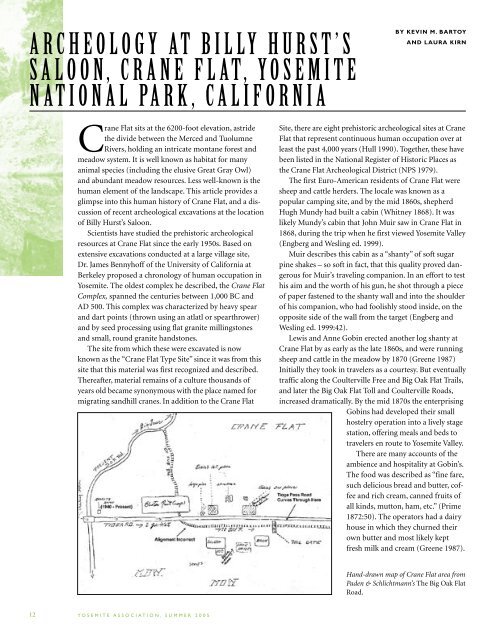

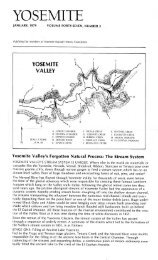
![(March 1982) [PDF] “We Are Pleased to Announce†- Yosemite Online](https://img.yumpu.com/51299748/1/190x242/march-1982-pdf-aeuroewe-are-pleased-to-announceaeur-yosemite-online.jpg?quality=85)
![[PDF] Old Horny, Yosemite's Unicorn Buck - Yosemite Online](https://img.yumpu.com/51269869/1/184x260/pdf-old-horny-yosemites-unicorn-buck-yosemite-online.jpg?quality=85)
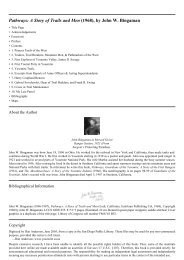
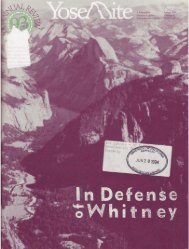
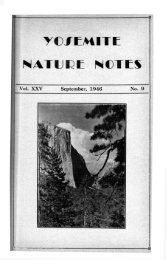
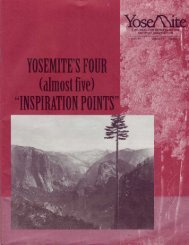
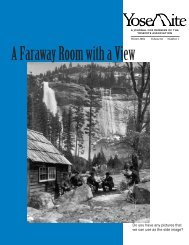
![1985 [PDF] - Yosemite](https://img.yumpu.com/48128837/1/184x260/1985-pdf-yosemite.jpg?quality=85)



